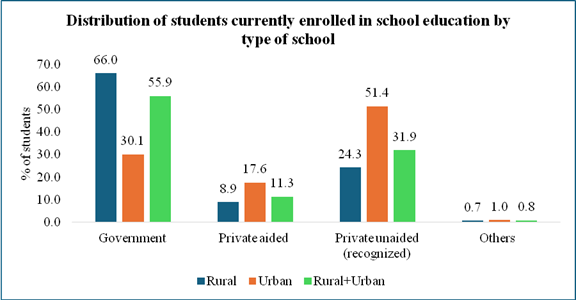Comprehensive Modular Survey: Education 2025

- 01 Sep 2025
In News:
The Comprehensive Modular Survey: Education (CMS:E), 2025, conducted under the 80th round of the National Sample Survey (NSS), provides valuable insights into household expenditure, enrolment trends, and private coaching patterns in school education.
Covering 52,085 households and 57,742 students, this survey, conducted through Computer-Assisted Personal Interviews (CAPI), offers nationally representative data at a critical juncture when India’s education sector is undergoing reforms under NEP 2020 and rapid digital transformation.
Key Findings of CMS: Education 2025
1. Enrolment Patterns
- Government schools dominate enrolment at 55.9%, with higher presence in rural areas (66%) compared to urban (30.1%).
- Private unaided schools account for 31.9% of enrolment, with stronger urban dominance.
2. Education Expenditure
- Average household spending per student:
- Government schools – ?2,863
- Non-government schools – ?25,002
- Overall, expenditure is significantly higher in urban areas (?23,470) than in rural areas (?8,382).
- Course fees constitute the largest expense (?7,111), followed by textbooks and stationery (?2,002).
3. Private Coaching
- Nearly 27% of students availed coaching, higher in urban areas (30.7%) than rural (25.5%).
- Expenditure gap: ?3,988 per student annually in urban areas vs ?1,793 in rural areas.
- At the higher secondary level, coaching costs rise to ?9,950 in urban areas compared to ?4,548 in rural areas.
4. Sources of Education Finance
- 95% of educational expenses were funded by household members.
- Only 1.2% students cited government scholarships as their primary funding source, highlighting weak institutional financial support.
Structural Developments in India’s Education Sector
- Digital and STEM Education: Initiatives like PM e-Vidya and Atal Tinkering Labs (8,000+ labs) promote digital and innovation-driven learning. India’s edtech sector attracted USD 3.94 billion (FY22), projected to grow further.
- Vocational and Skill Integration: NEP 2020 emphasizes skilling; the Union Budget 2025–26 allocated ?500 crore for AI Centres of Excellence in education.
- Rising Private Investment: With 100% FDI permitted, the Indian education market is projected to reach USD 125.8 billion by 2032.
- Higher Education Expansion: India now has 1,362 universities and 52,538 colleges, with Gross Enrolment Ratio (GER) rising to 28.4% (FY25).
- Multilingual & Inclusive Education: Under NEP 2020, focus on regional languages and digital content aims to bridge disparities.
Challenges in Indian Education
- Infrastructure Gaps – Only 47% schools have drinking water; 53% have separate girls’ toilets (2023 data).
- Teacher Shortage – Over 4,500 secondary teachers lack proper training; sanctioned positions declined by 6% (2021–24).
- Low Public Spending – India spends 3–4% of GDP on education, below NEP’s target of 6%.
- Socio-Economic Disparities – Tribal and disadvantaged children face linguistic and access barriers.
- Learning Outcomes – 75% of Class 3 students cannot read Grade 2 text, highlighting rote learning dependence.
- Digital Divide – Only 18.47% of rural schools have internet, compared to 47.29% in urban areas.
- Gender Barriers – 33% of girls drop out due to domestic responsibilities (UNICEF).
Way Forward
- Enhanced Investment in infrastructure, teacher training, and digital access.
- Targeted scholarships and financial aid to reduce household burden.
- Curriculum reforms to shift from rote learning to competency-based assessments (e.g., PARAKH).
- Inclusive education policies for tribal, rural, and girl students.
- Public-Private Partnerships to leverage innovation, funding, and technology.
Conclusion
The CMS: Education 2025 survey underscores the centrality of government schools, the rising cost burden on families, and the growing role of private coaching in shaping education outcomes. While India is witnessing rapid expansion, digitalization, and global investment, challenges of equity, quality, and access persist. Addressing these gaps through sustained policy focus, enhanced funding, and inclusive reforms is essential for realizing the NEP 2020 vision and achieving SDG 4: Quality Education.
